I made a drawn and printed A1 silk-screen portrait of Adrian Packer and wanted to complete the venture by sharing it with him.
I was content with how the portrait had developed. There are two versions: the ‘clean’ mimetic, drawn and printed version, and an elaborated duotone, version. They both have qualities of interpretation. However, as it is my methodology to share and offer a print to the subject, it would only be possible to finally accept the portrait was successful, when the subject’s opinion was embraced. Time to embrace the moment. I texted Adrian on a Monday lunchtime:

JT: Are u around this week?
AP: Yep usual coming and goings, but I can flex. When works for u?
JT: Could do this or wed eve? I have a surprise/present 4 u.
AP: Sounds interesting. What time this eve works for you?
JT: 7ish
AP: If you could do any earlier that would be fab but if not, no worries. See you when you get here!
JT: Will speed up.
AP: Fab I’m in the rectory pub next door.
I went to the art school Print room to pick up and stamp and sign two portraits : ‘Adrian’. As they lay side by side a student commented that she preferred the 2ndprint, because it was more of a ‘print’. On reflection she said the first may be more ‘pure’.
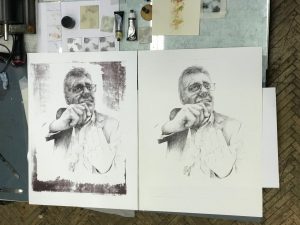
I rolled the prints up in newsprint and masking tape. They would have to be unrolled in front of the subject – Anxiety levels rise.
I have known Adrian since he became deputy head of the BOA creative academy; established the first academy at a premiership football club; took on the immense challenge of taking the “trojan horse’ school through a national trauma, and most recently to lead an academy trust of 5 secondary and one primary school with brilliantly diverse students.
Recently he took on a government challenge to produce a child focussed celebration of Holocaust Remembrance: ‘Echo Eternal’. I was moved by the tribute he had conceived and delivered by the diverse children of disadvantage, ability and latent talent expressing themselves through music, film and dance. Adrian had selflessly focussed on delivering this event and on the night, modestly refused to celebrate the deserved awarding of the Points of Light. He was focussed on ensuring the children were prepared, confident and ready to go onstage and celebrate the survivors with Echos for the future.
The children and musicians from the Royal Birmingham Conservatoire and Adrian’s supreme modestly for his role in the achievement, inspired me to revisit smart phone photographs I had ‘taken’ of Adrian 18 months ago, during a chat in the City Museum Edwardian Tea Rooms. This was the beginning of his portrait that I was about to share with him. Axious. Tense.
Adrian is a unique mix of selfless, ebullience, confidence, commitment and by his own thespian admission vanity.
We met with his COO, her son, new IT specialist and discussed how schools have to move into the 21stcentury. They discussed the change in address to staff and the CEO. No longer is he referred to by children, as Mr Packer, but ‘Adrian’. More tension rose as I had determined to title his portrait: ‘Adrian. I did not bring the portrait with me as I wanted to ensure Adrian was comfortable with receiving his gift alone, or with others. When his colleagues left, we caught up on the state of the world, Birmingham, the future of arts and education.
We talked and talked and then, what about the surprise gift?
“I’ll get it in a moment, but I should give you some background on where I am.” My PhD research is developing as well as being rightly challenging. For the first time in my life I am concentrating on portraiture. People. As a film-maker I recorded many people for programmes. We reminded ourselves that I had interviewed Adrian for a prospective programme on the reality of the unhelpfully titled ‘Trojan Horse’ episode. He had trusted me to bring cameras into the school and interview him, pupils and staff. That trust was rewarded by a deeply valuable recording of his motivations to succeed in putting right what the ‘grown ups’ had got wrong.
A portrait differs from a filmed interview, watched on a screen over time. If successful, it reflects for the viewer, much of the subject’s complexities and over riding qualities, in a single static image. Beyond the motivation to celebrate Adrian, I explained the context of making the portrait: I am researching contemporary portraiture that begins with a secret smart phone photograph.
I went out to get the surprise, and laid it on the table. It sat there, rolled up. Pregnant. Awaiting revelation.
We talked further as we prepared for the moment of sharing, revelation. We talked about the process, the ethics, consent and Trust. Anticipation was in the air.
I expressed how tense I was: “You may not like it, and if you don’t I will not share it any further.” “You are tense!!!! Is this being filmed? You send me a text out of the blue and offer me a surprise present – what’s going on? I want to know.”
I removed the masking tape and unrolled the large prints on paper, and held each end to reveal the first portrait.
Adrian was visibly moved by seeing himself reflected in a large singular manner. This was not vanity, but a sense of wonderment and personal revelation on seeing himself as perhaps, never before.

He explained how he can turn on a particular look, posture, smile for the camera. But that this is different. “I am caught unaware, which you have done to reflect me in my reality, not my pose(s).”
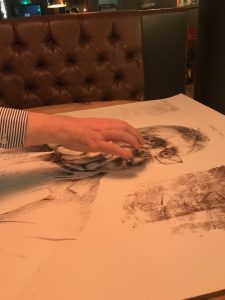
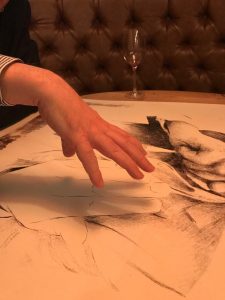
He touches the paper, the portrait, the face, the hands. The materiality of the image captured in the ink on paper drew him to it. He interpreted my choices of the image and in particular the hands in expressive motion. He saw the omission of detail from the foremost hand in contrast to the detailed shading of the hand in front of this animated face, encouraging the viewer’s eye to be drawn to his eyes.
“My hair – I am vain. I am always aware of what to cut. He ran his fingers across the title at the bottom of the print. You have made a tribute to me. I am not used to accepting such accolades, even when I receive them out of the best reasons.”
The second more ‘printerly’ portrait was revealed. The artist explains the process of making additional marks that brought shape and colour to the image. Further silk screen marks surrounding the portrait had been included. Irregular and unpredictable framing within the frame of the paper. More tactile and revealing of the materiality of the portrait and its making. Both versions were offered without a final conclusion as to which worked best. On reflection the first more ‘pure’ version was closer to the subject’s heart.
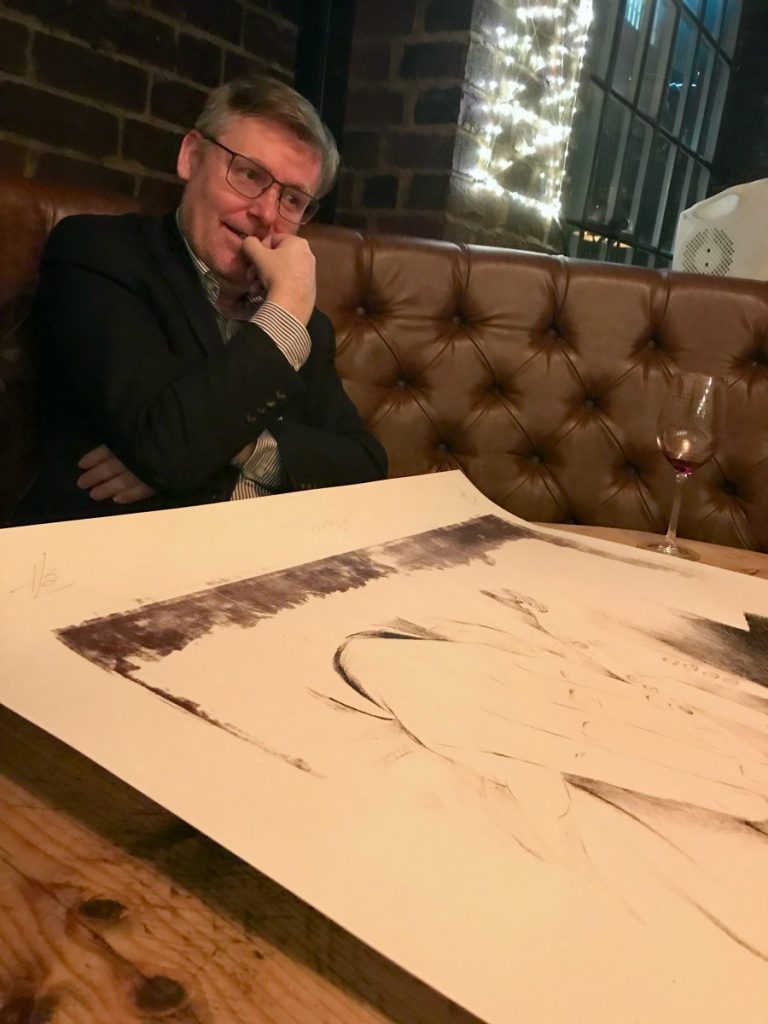
Beyond the drawn and printed practice research is an opportunity to answer ethical questions of consent. In litigious and unconsenting times some might say I, as the artist, could be stealing and unethical in not obtaining prior participant consent, before ‘taking’ a surrepticious photographic image.
I explained my rationale. That in many cases I do not want to ‘sully/disrupt/interfere’ with a friendship and trust with the subject, before making a portrait that satisfactorily reflects the subject and is worthy of sharing, and ultimately gifting to them.
“I get it. That’s what its about. Because you are trusting of the relationship between you and the subject, without asking for consent, before you go on to make the work. You are flipping it all on its head. You are nuts – I’m going to get you sectioned” This was a reference to ‘Sectioned’ a BBC programme my company had made with adults under section. It was the first time this had been achieved on mainstream television and demanded extremely precise consents by subjects, families and social services. Adrian had always deeply respected this programme.”
Excitedly Adrian used his smart phone to take pictures of his portrait and shared it with his family and to our mutual friend Sir Nick Williams, retired Principal of the Brit School, co founder of BOA and the person who introduced us originally.
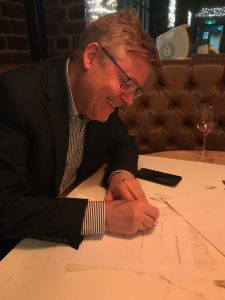
Adrian asked when I had taken the photograph. “During a discussion without asking for consent 18 months ago. I have developed a participant retrospective consent form to ensure the process is ethical. I presented the consent form to him as a necessity for inclusion in the PhD research.
He was animated and clear: “I understand the necessity for consent. But this joyous sharing is based on our mutual trust. I don’t want to read it. I’ll sign it. We trust each other. Your portrait shows that.”
Art is the space for debate. For coming together to share without parameters. This is Joyous. It is a gift.
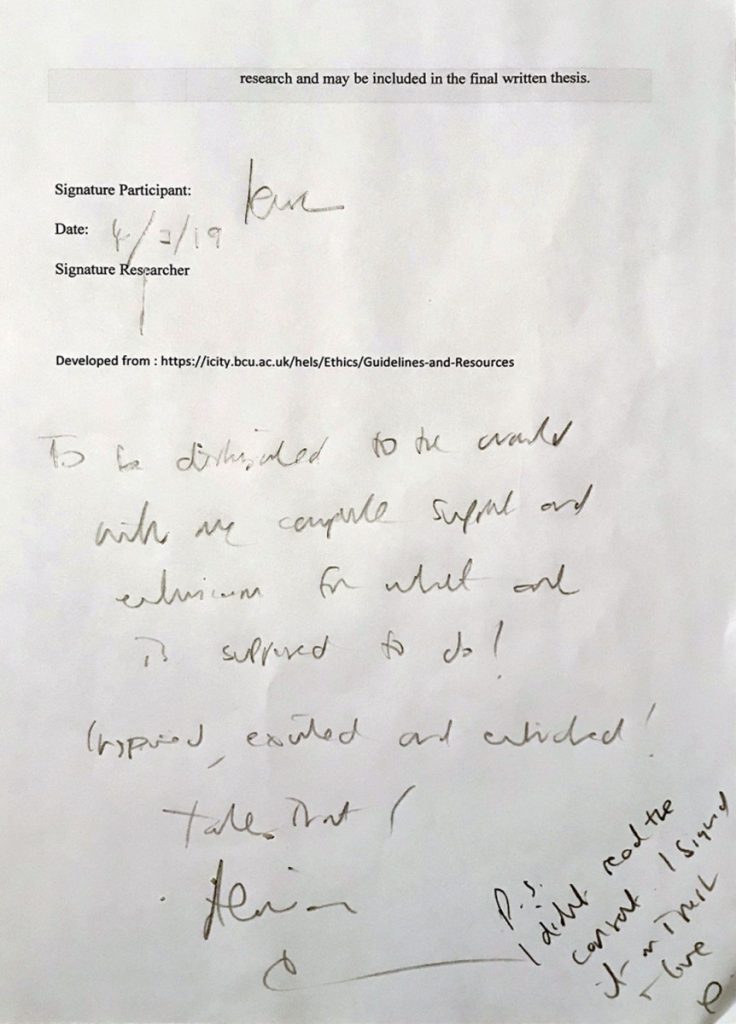
P.S. ‘I didn’t read the consent. I signed it on Trust and Love.’
The portraits were rolled up and three hours since we sat round this table we were ready to go. As we reached the street I said: “I wanted to make it for you after Echo Eternal.”
We parted with a big hug and Adrian smiled: “I’ll get you back.”
Sitting in my car my anxiety had been overtaken and replaced with a sense of warmth and confirmation. My artistic efforts had been rewarded by the subject that I had ‘taken’ an image from, to begin the process of representing them in their completeness, as I experience them.
Before arriving home my phone lit up with texts from Adrian’s COO, with whom he had shared his portrait . She is moved by what has been reflected and shares with her company:
‘Our CEO is captured perfectly and joyfully in this moment of profound and truthful trust between artist and subject.’
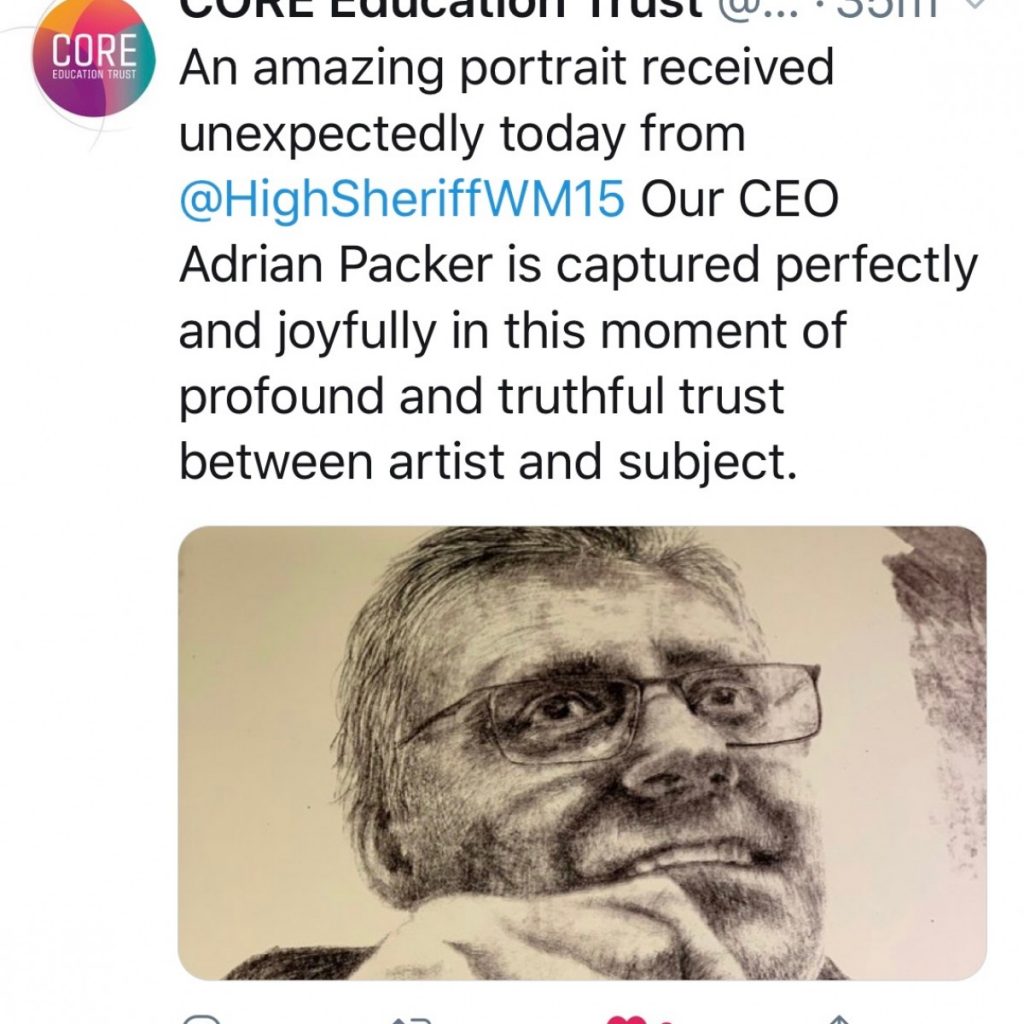
This is a positive effect of the work, beyond artist and subject.
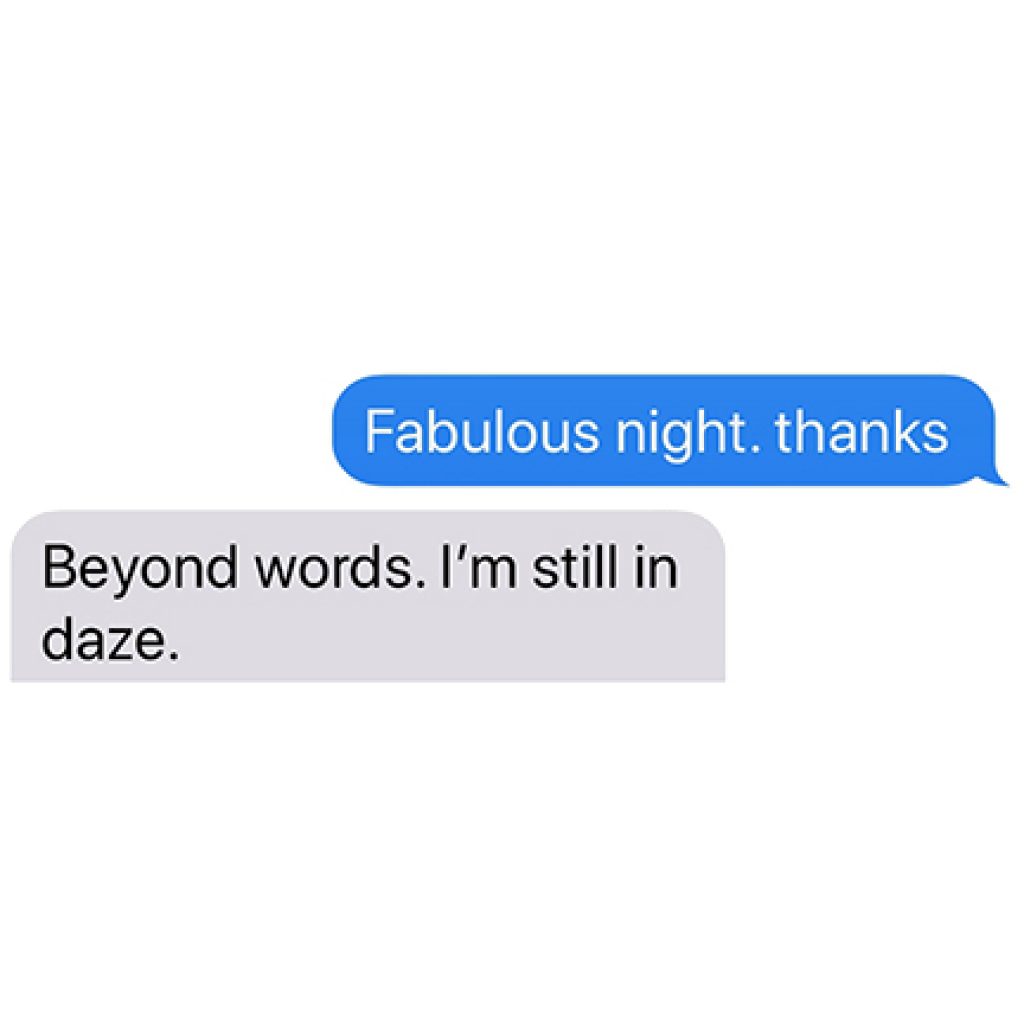
This is a record of an exchange. A case study. It is not a robust academic response, but may form the basis of such.

